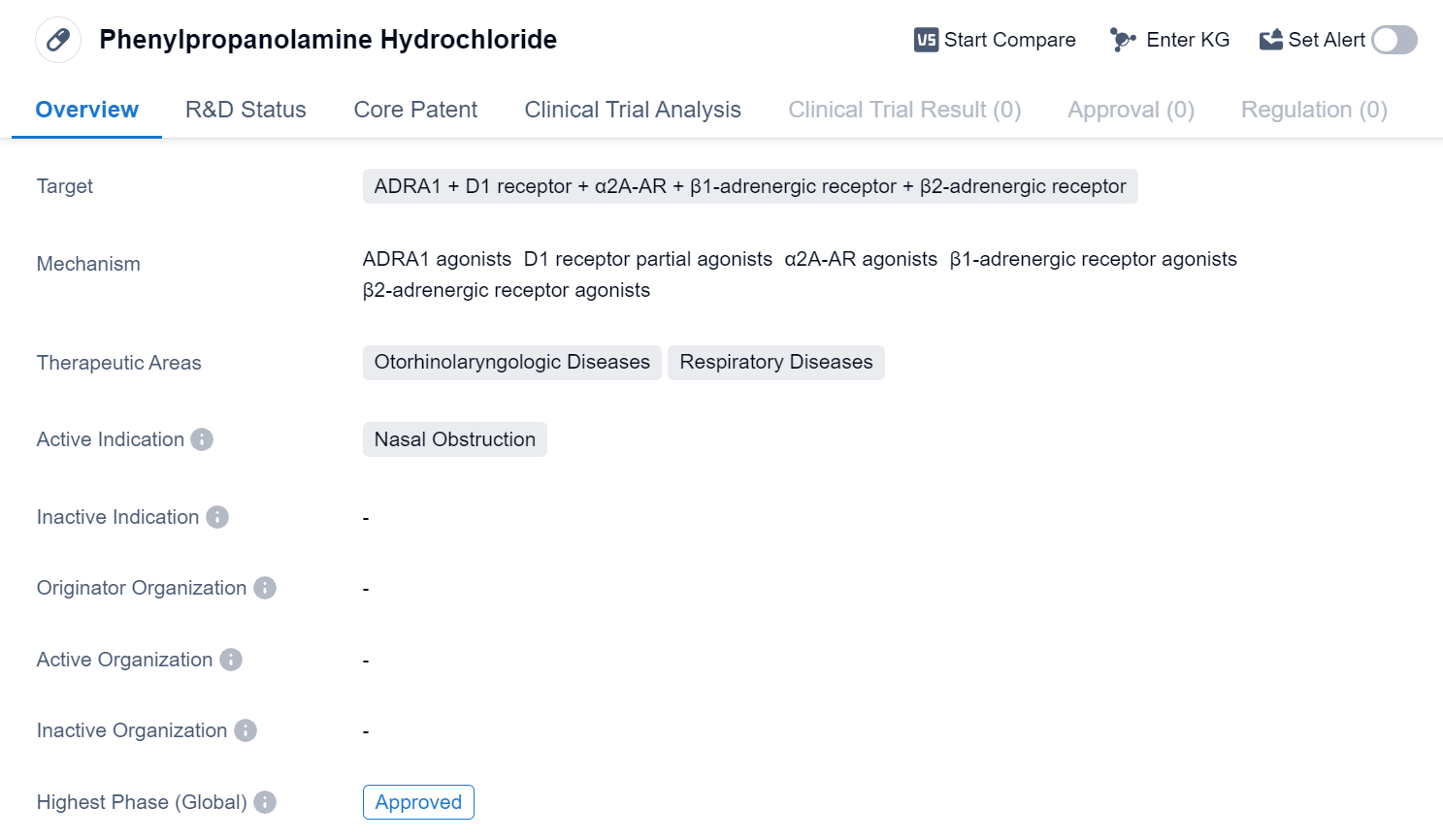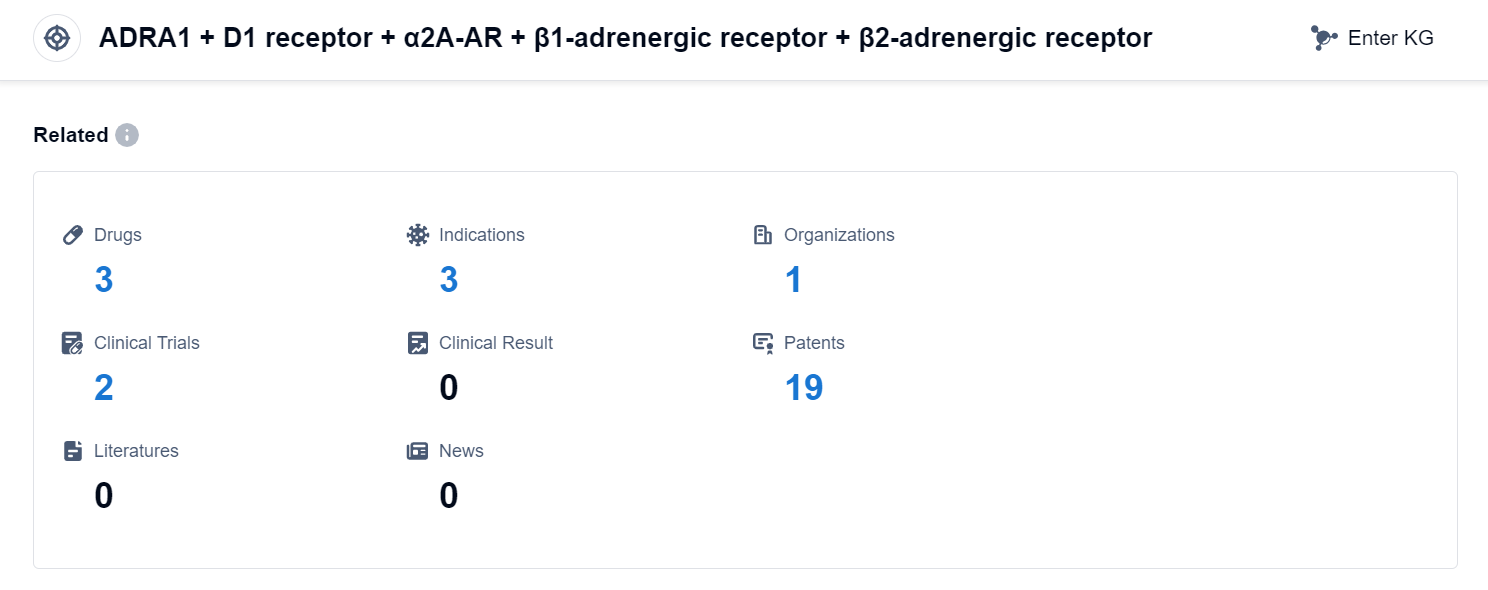Pharmaceutical Insights: Phenylpropanolamine Hydrochloride's R&D Progress
Phenylpropanolamine Hydrochloride's R&D Progress
Phenylpropanolamine Hydrochloride is a small molecule drug that has been approved for use in the treatment of nasal obstruction. It targets several receptors including ADRA1, D1 receptor, α2A-AR, β1-adrenergic receptor, and β2-adrenergic receptor. This drug falls under the therapeutic areas of otorhinolaryngologic diseases and respiratory diseases.
Nasal obstruction is a common symptom associated with various conditions such as allergies, sinusitis, and the common cold. It is characterized by the blockage or congestion of the nasal passages, leading to difficulty in breathing through the nose. Phenylpropanolamine Hydrochloride aims to alleviate this symptom by targeting multiple receptors involved in nasal congestion.
The drug's mechanism of action involves its interaction with ADRA1, D1 receptor, α2A-AR, β1-adrenergic receptor, and β2-adrenergic receptor. By targeting these receptors, Phenylpropanolamine Hydrochloride may help to constrict blood vessels in the nasal passages, reducing inflammation and relieving congestion. This mechanism of action suggests that the drug may have a vasoconstrictive effect, which can help improve airflow and alleviate nasal obstruction.
The highest R&D phase of Phenylpropanolamine Hydrochloride is approved. The approval of this drug suggests that it has met the necessary regulatory requirements and has been deemed suitable for use in patients.
Given its approved status and its specific indication for nasal obstruction, Phenylpropanolamine Hydrochloride may be a valuable treatment option for individuals suffering from this condition. However, it is important to note that further research and clinical studies may be required to fully understand the drug's effectiveness, potential side effects, and its use in different patient populations.
👇Please click on the image below to directly access the latest data (R&D Status | Core Patent | Clinical Trial | Approval status in Global countries) of this drug.
Mechanism of Action for Phenylpropanolamine Hydrochloride: ADRA1 agonists & D1 receptor partial agonists & α2A-AR agonists & β1-adrenergic receptor agonists & β2-adrenergic receptor agonists
ADRA1 agonists: ADRA1 agonists are a type of medication that activate the alpha-1 adrenergic receptors in the body. These receptors are found in various tissues and organs, including blood vessels, smooth muscles, and the central nervous system. By stimulating these receptors, ADRA1 agonists can have several effects such as vasoconstriction (narrowing of blood vessels), increased blood pressure, and relaxation of smooth muscles.
D1 receptor partial agonists: D1 receptor partial agonists are drugs that selectively bind to and activate the dopamine D1 receptors in the brain. These receptors are involved in various neurological processes, including cognition, motivation, and reward. By acting as partial agonists, these medications produce a moderate activation of the D1 receptors, which can have therapeutic effects in conditions such as Parkinson's disease and schizophrenia.
α2A-AR agonists: α2A-AR agonists refer to medications that specifically target and activate the alpha-2A adrenergic receptors. These receptors are primarily found in the central nervous system and play a role in regulating neurotransmitter release. By stimulating α2A-AR receptors, these agonists can have various effects, including sedation, analgesia (pain relief), and regulation of blood pressure.
β1-adrenergic receptor agonists: β1-adrenergic receptor agonists are drugs that selectively activate the beta-1 adrenergic receptors. These receptors are predominantly located in the heart and are involved in regulating heart rate and contractility. By stimulating β1 receptors, these agonists can increase heart rate, enhance cardiac output, and have positive inotropic effects (increased force of contraction).
β2-adrenergic receptor agonists: β2-adrenergic receptor agonists are medications that specifically target and activate the beta-2 adrenergic receptors. These receptors are primarily found in the smooth muscles of the lungs, blood vessels, and uterus. By binding to β2 receptors, these agonists cause relaxation of smooth muscles, leading to bronchodilation (widening of airways), vasodilation (widening of blood vessels), and relaxation of uterine muscles.
In summary, the terms mentioned are different types of receptor agonists that act on specific receptors in the body. Each agonist has its own target receptor and produces distinct physiological effects.
Drug Target R&D Trends for Phenylpropanolamine Hydrochloride
According to Patsnap Synapse, as of 10 Sep 2023, there are a total of 3 ADRA1 + D1 receptor + α2A-AR + β1-adrenergic receptor + β2-adrenergic receptor drugs worldwide, from 1 organizations, covering 3 indications, and conducting 2 clinical trials.
Based on the analysis of the provided data, the current competitive landscape for the target ADRA1 + D1 receptor + α2A-AR + β1-adrenergic receptor + β2-adrenergic receptor is as follows:
- Novartis AG is the company with the highest phase of development, although it is currently listed as inactive, requiring further investigation into their R&D progress.
- There are three indications with approved drugs, namely cough, hyperemia, and nasal obstruction, indicating potential therapeutic options in these areas.
- Small molecule drugs are progressing in the highest phase, with two approved drugs and one inactive drug.
- The United States is leading in the development phase, with one approved drug and one inactive drug. The progress in China is not mentioned in the provided data, requiring further analysis.
Future development of the target ADRA1 + D1 receptor + α2A-AR + β1-adrenergic receptor + β2-adrenergic receptor will depend on the R&D progress of companies, the exploration of new indications, the advancement of small molecule drugs, and the development in different countries/locations. Further analysis and research are necessary to fully understand the competitive landscape and potential future developments in this target.
👇Please click on the picture link below for free registration or log in directly if you have a freemium account, you can browse the latest research progress on drugs, indications, organizations, clinical trials, clinical results, and drug patents related to this target
Conclusion
In conclusion, Phenylpropanolamine Hydrochloride is a small molecule drug that targets multiple receptors involved in nasal obstruction. It has been approved for use in treating this condition and falls under the therapeutic areas of otorhinolaryngologic diseases and respiratory diseases. Its mechanism of action suggests that it may help alleviate nasal congestion by constricting blood vessels in the nasal passages.






